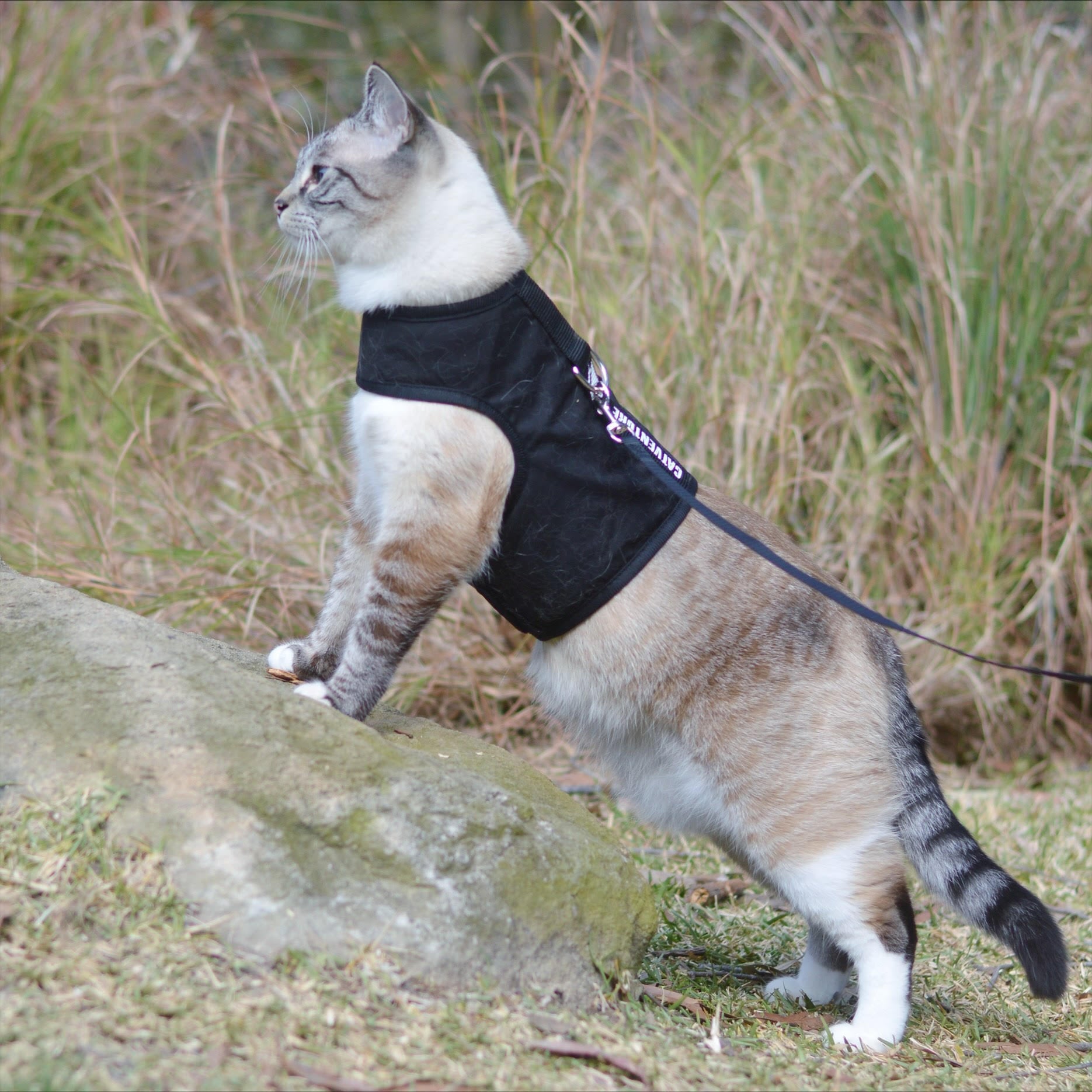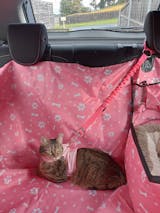Should Cats Wear Harnesses? Understanding Your Furry Friend's Needs
"Should cats wear harnesses?" You may have pondered this question if you're a cat owner. In fact, yes, cats can and should wear harnesses, particularly when you plan to take them outside. Harnesses provide an excellent way to keep your cat safe and near you during outdoor adventures.
There are numerous reasons why a cat harness can be beneficial. For one, cats are naturally curious creatures. When you take them outside, they may want to explore, and a harness can help ensure they don't wander off too far. Moreover, a harness can provide an effective way to get your cat to exercise, reducing the risk of obesity and promoting overall health.
However, it's important to remember that not all cats will take to wearing a harness immediately. Some cats may require a little extra time and patience to get used to the new experience. It's crucial to introduce the harness to them gradually, in a non-threatening and positive way.

What Harness is Best for My Cat? Make the Right Choice
Choosing the right harness can be a bit overwhelming given the variety available. But the key factors to consider are the harness's fit, adjustability, comfort, ease of use, and security.
A well-fitted harness is snug but not too tight. It should not restrict your cat's movement or cause discomfort. Adjustable straps are also a must, as they allow for a custom fit, regardless of your cat's size or body shape. A good cat harness is also easy to put on and take off, saving you a lot of struggle and stress.
Lastly, the harness should be secure to prevent your cat from escaping. This is especially important when you're outside, as an escape could lead to your cat getting lost or encountering hazards. Look for a harness designed to be escape-proof, providing peace of mind for both you and your cat.
Should I Put My Cat in a Harness for the Vet? Secure Vet Visits
Taking your cat to the vet can sometimes be a stressful experience for both of you. Using a harness during vet visits can make the process smoother and less anxiety-inducing for your cat.
The harness gives your cat a sense of security and safety, which can be particularly comforting in a new and unfamiliar environment like a vet clinic. It can also prevent your cat from darting off in fear or curiosity, reducing the risk of accidents or injuries.
Moreover, if your cat tends to get anxious or unruly during vet visits, a harness can provide an effective way to control their movements without causing them discomfort or distress. This can make the visit less stressful for you, the vet, and most importantly, your cat.
Is There a Cat Harness That Won't Come Off? Ensure a Safe Adventure
If you're worried about your cat slipping out of their harness, there are solutions available. Escape-proof cat harnesses are designed to stay on securely, thanks to their special features.
An escape-proof harness typically has a unique design that covers more of your cat's body compared to a standard harness. This makes it harder for your cat to wriggle free. Adjustable straps are also an essential feature of an escape-proof harness, ensuring a secure and snug fit regardless of your cat's size or body shape.
However, while an escape-proof harness can provide additional security, it's also important to monitor your cat while they're wearing it, especially in the beginning. Make sure they're comfortable and not showing signs of distress. And remember, always keep a close eye on your cat during outdoor adventures.
Why Do Cats Flop Over When You Put a Harness on Them? Funny Feline Behaviour
It's indeed quite humorous and endearing to see cats flop over when they first wear a harness. This behaviour, often referred to as "going limp" or "playing dead", is a common response to the unfamiliar sensation of wearing a harness. But rest assured, this is quite normal and doesn't mean your cat is in distress.
One theory is that the pressure from the harness triggers a natural response similar to what kittens experience when their mother carries them by the scruff of their neck. When carried this way, kittens instinctively relax and go limp. The same might be happening when your cat wears a harness for the first time.
While this behavior can be a bit surprising, it's important not to panic or immediately remove the harness. Most cats will gradually get used to the sensation and start moving normally after a while. It's all a part of the process of getting used to wearing a harness.
How Do I Stop My Cat from Slipping Out of His Harness? Securing Your Furry Escape Artist
If your cat keeps slipping out of their harness, it might be due to several reasons such as an ill-fitted harness or a lack of familiarity. However, there are several steps you can take to prevent this.
First, ensure the harness fits your cat well. It should be snug enough to prevent your cat from slipping out but not too tight that it's uncomfortable. A harness with adjustable straps can help achieve the perfect fit.
Second, introduce the harness to your cat gradually. Let them sniff and explore it first before putting it on them. Associating the harness with positive experiences, like treats or playtime, can also make your cat more willing to wear it.
Finally, monitor your cat while they're wearing the harness, especially in the beginning. If you notice any signs of distress or discomfort, adjust the harness or consult with a vet.
Is a Cat Harness Safer Than a Collar? Harness vs Collar: The Safer Choice
When compared to a collar, a harness is generally considered safer for several reasons. A harness provides better control over your cat without the risk of causing harm.
Unlike a collar, a harness distributes pressure evenly across your cat's body, reducing the risk of injuries. A collar, on the other hand, can put too much pressure on your cat's neck, which can cause discomfort or even injury.
Moreover, a harness is more secure than a collar. It's harder for cats to slip out of a harness compared to a collar. This means that your cat is less likely to escape and get lost or into danger when wearing a harness.
However, regardless of whether you choose a collar or a harness, it's important to ensure it's a good fit and doesn't cause your cat any discomfort.
How Do You Get an Unwilling Cat into a Carrier? Carrying Your Cat with Care
Getting an unwilling cat into a carrier can be a tricky task. But with a bit of patience and some clever strategies, it can be done.
First, make the carrier a comfortable and familiar place for your cat. Leave it open in your home and put a blanket or a piece of clothing with your scent inside it. This can help your cat associate the carrier with safety and comfort.
Second, try using treats or toys to lure your cat into the carrier. Place these inside the carrier and wait for your cat to go in by themselves. Never force your cat into the carrier as it can cause them stress and make them associate the carrier with negative experiences.
Finally, be patient and calm. Cats are very intuitive and can sense your stress or frustration. Keeping a calm demeanor can help make the process smoother.
Is It Safe to Walk a Cat on a Harness? Safely Strolling with Your Cat
Walking a cat on a harness can be a safe and fun experience for both of you. It's a great way for your cat to explore the outdoors, get some exercise, and satisfy their curiosity.
However, it's important to take some precautions. Make sure your cat is comfortable wearing the harness and is familiar with the outside environment before you take them for a walk. Always keep an eye on your cat and steer clear of potentially dangerous areas, like busy roads or areas with aggressive animals.
Remember, not all cats may enjoy walking on a harness. Some cats might prefer to stay indoors, and that's completely okay. It's important to respect your cat's preferences and comfort levels.
Should I Take My Cat on a Walk? Fun Feline Adventures
Taking your cat for a walk can be a rewarding experience for both of you. It can provide your cat with mental stimulation and physical exercise, which can contribute to their overall well-being.
However, whether or not you should take your cat on a walk depends on their personality and comfort levels. Some cats might love the adventure, while others might prefer the safety and familiarity of their home.
If you do decide to take your cat on a walk, make sure to do it safely. Use a well-fitted harness and leash, and always keep a close eye on your cat. It's also a good idea to start with short walks in a quiet area before venturing further.
How Do You Train a Cat to Wear a Harness? Patience and Positive Reinforcement
Training a cat to wear a harness may take some time and patience, but with the right approach, it's certainly achievable. The key is to make the experience positive for your cat.
Start by introducing the harness slowly. Let your cat sniff and explore it first. Then, you can try putting it on your cat without fastening it. Reward your cat with treats or praise each time they interact positively with the harness.
Gradually increase the amount of time your cat spends wearing the harness. Start with short sessions indoors, and gradually increase the duration. Once your cat seems comfortable wearing the harness indoors, you can start introducing them to the outdoors.
Remember, each cat is different and will react to the harness in their own way. It's important to respect your cat's pace and never force them to wear the harness if they seem distressed.
What Age Should a Cat Wear a Harness? Start Them Young
The best age to introduce a harness to a cat is when they're still a kitten. At this age, they're more adaptable and more likely to get used to the feeling of wearing a harness. But remember, patience and gradual exposure are key, even with kittens.
However, this doesn't mean that adult cats can't learn to wear a harness. It might take a little more time and patience, but many adult cats can become comfortable with a harness with the right approach.
Regardless of your cat's age, always ensure the harness is the right size and doesn't cause any discomfort. And remember, the goal is to make the experience as positive as possible for your cat.





















